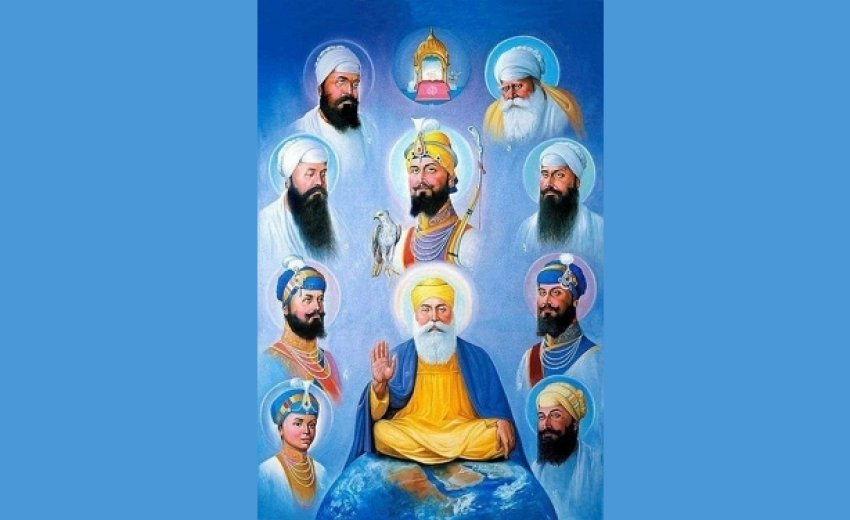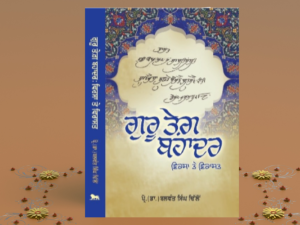Introduction
Sikhism (known as Sikhi in Punjabi language and common parlance) is the youngest world religion that had its origin in India during the 15th century. Guru Nanak Dev (1469 to 1539) was the founder of the Sikh religion. He was born in Talwandi Rai Bhoe Ki, now called Nankana Sahib in present day Pakistan, on 15 April, 1469. Guru Nanak was born in a Hindu family, but he revolted against the Hindu traditions of his family as a young boy of nine. During his employment in the Modikhana (Store House) of Nawab Daulat Khan Lodhi at Sultanpur Lodhi, he had an encounter with God which changed his life. His first sermon was ‘there is no Muslim, no Hindu’; all are born as human beings on this earth. It is considered that Sikhism began with the preaching of Guru Nanak’s first sermon at Sultanpur Lodhi.
Guru Nanak resigned his job in the service of Nawab and started his journeys in Asia. He travelled 40,000 kms. on foot passing through Afghanistan, Iran, Iraq, Saudi Arabia, Tibet, Nepal and Sri Lanka during the next 24 years. The purpose of his travels was to meet religious leaders of different faiths to exchange his message of universal brotherhood. He won a large number of adherents to his teachings. It was the beginning of a new religious fellowship, which, in course of time, developed into a well-defined new faith with its own institutions and sacred scripture.
Definition of Guru and Sikh Gurus
The term “Guru” when applied to Guru Nanak and his nine successors means spiritual Enlightener. The term Guru in the Hindu tradition means a spiritual guide and instructor. In the Sikh scripture, however, the term Guru is often used by the Sikh Gurus and others in this sense as well as for God Himself. The role of the Sikh Gurus, however, was different from that of the Hindu Gurus: instead of imparting knowledge of God based on the existing scriptures, they acted as revealers of truth (God). Their revelations formed the basis of Sikhism. The Sikh Gurus did not claim to be incarnations of God, or God in human form. Sikhism does not believe in the theory of incarnation, because God does not take birth.
The Guru is a messenger of God sent to enlighten mankind. He is one who has realized God. The disciple, known as Sikh, has to reflect on the Guru’s teachings, be convinced of its truth in his mind, practice it in thought, word and deed, and pray for Divine Grace. He then obtains liberation from the cycle of birth and death while living a normal life. The Guru teaches the disciple how to link his own consciousness to Divine Consciousness. He makes the disciple see the vision of God within his own heart. The Sikh Gurus were ordinary human beings, but when they were blessed by Divine Grace, they became perfect and capable of guiding mortals on the spiritual path. The Sikh Gurus were treated with great reverence and people turned to them for instruction because of their wisdom and their moral piety.
The new religion founded by Guru Nanak was nurtured by nine other Gurus who succeeded him in the holy office of Guruship in the following order:
1. Guru Nanak Dev 1469-1539 A.D.
2. Guru Angad Dev 1539-1552 A.D.
3. Guru Amar Das 1552-1574 A.D.
4. Guru Ram Das 1574-1581 A.D.
5. Guru Arjun Dev 1581-1606 A.D.
6. Guru Hargobind 1606-1644 A.D.
7. Guru Har Rai 1644-1661 A.D.
8. Guru Har Krishan 1661-1664 A.D.
9. Guru Tegh Bahadur 1664-1675 A.D.
10. Guru Gobind Singh 1675-1708 A.D.
Institutionalization of Sikh Religion
Guru Nanak started the institutions of dharamsala, sangat, pangat and langar. The succeeding Gurus further consolidated and extended these institutions. Guru Amar Das systematized the institution of manjis and selected twenty-two centres for this mission. Persons of high religious calibre were nominated to these offices. They were in charge of the Guru’s followers in an area and catered to their religious as well as temporal needs. They collected the offerings and passed the same on to the central treasury where they were used by the Guru for the purposes of the mission. Guru Arjun further regularised the collection of these contributions. He fixed the amount to be one tenth of one’s income that every Sikh should set apart for the common cause.
Guru Arjun Dev compiled Guru Granth Sahib, the sacred scripture of the Sikhs, consisting of the hymns of the Gurus and other saints. Guru Arjun Dev felt that there should be one Religious Book as the scripture and one central place — Harimandar Sahib — to be the rendezvous for the new religion and he accomplished both for the further development of the new faith. The word of Guru Granth Sahib is equated with the Guru himself. “The Gurbani is the Guru, and the Guru the Gurbani'' sang Guru Ram Das. On August 16, 1604 A. D. Guru Arjun ceremoniously installed the sacred volume of Guru Granth Sahib in the centre of the inner sanctorum in the newly-built Harimandar Sahib. The high level of sanctity and reverence accorded to the Harimandar (now called Golden Temple) could not have been possible without Guru Granth Sahib enshrined in it.
Guru Granth Sahib became the nucleus of the Sikh way of life and of all religious observances of the Sikhs. The Gurbani, containing spiritual knowledge, became the object of the highest reverence for the Sikhs, as well as for the Gurus themselves. Guru Arjun Dev, the compiler of Guru Granth Sahib, has very clearly and emphatically declared the independent position of Sikhism vis-a-vis Hinduism or any other religion:
“ I do not keep the Hindu fast nor the Muslim Ramadan;
I serve Him alone who is my refuge
I serve the One Master; who is also Allah
I have broken with the Hindu and the Muslim,
I do not worship the Hindu way nor like the Muslim go to Mecca,
I serve Him alone and no other,
I will not pray to idols nor say the Muslim prayer
I shall put my heart at the feet of the one Supreme Being
For, we are neither Hindus nor Mussalmans.” (SGGS, M. 5, p. 1136)
With such an authoritative statement, from the pen of the compiler Guru of the sacred scripture of the Sikhs, it is not understood how non-Sikhs can keep asserting persistently that Sikhism is a sect of Hinduism.
Installation of Guru Granth Sahib as the Living Guru of the Sikh Religion
Guru Gobind Singh, the tenth and last living Guru of the Sikhs, conferred Guruship on the Aad Granth compiled by Guru Arjan Dev as sacred scripture of the Sikhs. He ordained that after him, Guru Granth Sahib shall be the Guru of the Sikhs. He installed Guru Granth Sahib as his successor, thus putting an end to the line of living Gurus. Guru Gobind Singh thus gave the institution of Guruship a permanent character by vesting in it the immortality of Guru Granth Sahib. After the conferment of Guruship on the Granth Sahib, it began to be addressed as Guru Granth Sahib. The Khalsa Panth was given the temporal authority and Guru Granth Sahib the Spiritual authority of Sikh religion. The lineage of living Guru was stopped and there is no longer any place in the Sikh faith for a new living Guru. It is for this reason that any attack on a gurdwara is considered by the Sikhs as an attack on their Guru, and a Sikh will not hesitate to lay down his life in defence of his gurdwara. “The freedom of their gurdwaras has always been the measure of the Sikhs’ freedom or prosperity”, writes Teja Singh in Essays on Sikhism.
Miri – Piri System in Sikh Religion
After the martyrdom of Guru Arjun Dev on the orders of Mughal Emperor, Jehangir, his son Guru Hargobind took the seat of his father with two swords girded round his waist, one symbolising spiritual power and the other temporal authority. He was a witness to how peaceful resistance to oppression had proved abortive, so he decided to take recourse to the sword as a rightful alternative for self-defence. Opposite the Harimandar (now called Golden Temple), he built the Akal Takht (The Throne of the Timeless God). He sat on a throne-like structure and held court in the way of Mughal Emperor of India to challenge his authority. He received envoys, settled disputes and administered justice. Ever since then, the Akal Takht has remained the seat of the spiritual and temporal authority of the Sikhs. This transformation in the mode of Sikh philosophy is known as Miri – Piri System in Sikh Religion. It is specific to Sikh religion only.
Creation of the Khalsa Panth
Guru Gobind Singh did not change the religion preached by the preceding nine Gurus. Some historians misunderstood the creation of the Khalsa as the sword arm of the Sikh religion. The purpose of Guru Gobind Singh was to implement the message of Guru Nanak in letter and spirit. The process had been started by Guru Hargobind by wearing two swords of Miri and Piri. Tenth Guru wanted to mould the Sikhs into a nation and then to fire that nation with an ideal — the ideal of the Khalsa Commonwealth. His greatest achievement was the establishment of the Khalsa by the famous amrit ceremony on 30th March, 1699 by which he created the Khalsa, and bestowed on them his blessings and the gift of valour in war.
Guru Gobind Singh bound the Khalsa to a strict code of conduct (Rahitnama), and with unshorn hair, beard and turban, he gave the Sikhs a distinct identity. He ordained that they should uphold righteousness in every place and destroy evil in every form by all means available and should not submit to oppression and tyranny but resist it, if necessary, by force. Guru Gobind Singh also made it explicitly clear that Sikhs were neither Hindus nor Muslims, and forbade worship of any of their idols or tombs; nor were they to follow the teachings of their holy books. Only Guru Granth Sahib was to be their Sacred Scripture.
An Overview of the Sikh Religion
Sikhism, a revealed religion, is the youngest among the major world faiths. This system, as preached by Guru Nanak, has a universal appeal and an eternal relevance. Guru Nanak is, in fact, the revealer of a new gospel, the founder of a new faith, the perfect example of piety and deep devotion. The chief doctrines of Sikh Religion are enumerated as under:
(a) Monotheism: Guru Nanak believed in only One God as the Ultimate Reality.
(b) Reality Of The World: Guru Nanak rejected the earlier view of the world being mithya or unreal or a place of suffering and human life as a punishment. Since God is Real, he argued, so is His creation — ‘the continents, the universe, the worlds and the forms ......’
(c) Goal of Life: In Sikhism, the goal is not moksha, nirvana or personal salvation after death. The goal is to attain the status of gurmukh or sachiara or a godman in this life.
(d) Equality And Human Dignity: Sikhism recognises no distinction on the basis of birth or otherwise between man and man. The Guru rejected the 3,000 year old caste system in India. His concept of equality for women can never be surpassed. He also preached a life of honour and dignity: ‘He who lives with dishonour, does not deserve the food he eats’, says the Guru.
(e) Development of the Society: Guru Nanak was not concerned with the individual alone. His concern covered the society as a whole. Based on the gospel preached by him, he founded a settlement towards the end of his mission at Kartarpur, which was open to all, and in which everybody worked and ate together. The doctrine of Kirat Karo, Vand Chhako and Naam Japo was introduced by Guru Nanak in Karatrpur.
(f) The Scripture: The Adi Granth, compiled by Guru Arjun Dev, with later addition of bani of Guru Tegh Bahadur, is the sacred scripture of the Sikhs. The scripture was given the status of living Guru by the Tenth Master. This appointment of the Scripture or the Word as Guru is unique to Sikhism. It simply means that in spiritualism the real Guru is the ‘Word’ or the command or shabad of the Lord, and not the human body. Also, it is only in Sikhism that the Scripture was written and authenticated by the founder himself or his successors. In other religions, the scriptures were written decades or even centuries after the founders had left.






